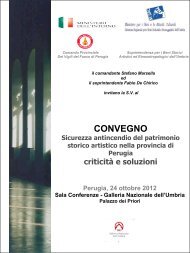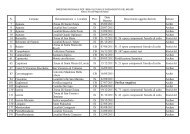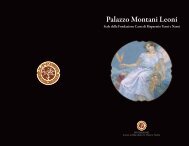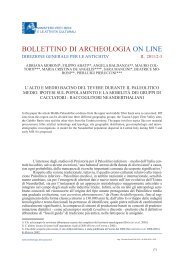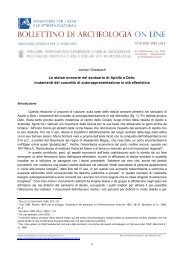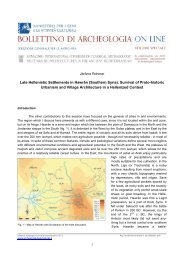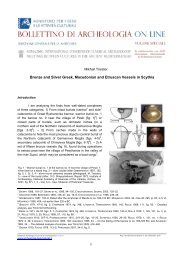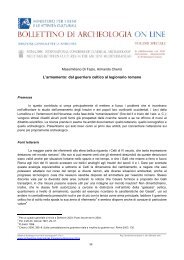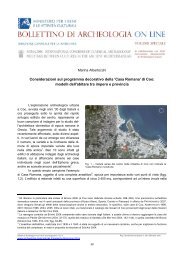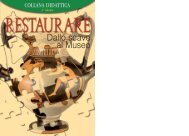The agricultural colonization of the Pomptinae Paludes: surveys in ...
The agricultural colonization of the Pomptinae Paludes: surveys in ...
The agricultural colonization of the Pomptinae Paludes: surveys in ...
You also want an ePaper? Increase the reach of your titles
YUMPU automatically turns print PDFs into web optimized ePapers that Google loves.
Early roman <strong>colonization</strong><br />
Tymon de Haas<br />
<strong>The</strong> <strong>agricultural</strong> <strong>colonization</strong> <strong>of</strong> <strong>the</strong> <strong>Pompt<strong>in</strong>ae</strong> <strong>Paludes</strong>:<br />
<strong>surveys</strong> <strong>in</strong> <strong>the</strong> lower Pont<strong>in</strong>e pla<strong>in</strong><br />
Our picture <strong>of</strong> <strong>the</strong> Roman conquest <strong>of</strong> <strong>the</strong> Italian Pen<strong>in</strong>sula (roughly between <strong>the</strong> 6 th and 3 rd centuries<br />
BC) is largely based on historical sources that describe Rome as <strong>the</strong> power that first came to dom<strong>in</strong>ate its<br />
Lat<strong>in</strong> allies and subsequently took <strong>the</strong> <strong>in</strong>itiative for territorial expansion <strong>in</strong>to areas <strong>in</strong>habited by o<strong>the</strong>r tribes;<br />
<strong>the</strong> found<strong>in</strong>g <strong>of</strong> colonies <strong>in</strong> alien territory was an important part <strong>of</strong> this expansion strategy. <strong>The</strong> colonies,<br />
however, were not only military strongholds, as <strong>the</strong>y received considerable numbers <strong>of</strong> colonists that worked<br />
<strong>the</strong> surround<strong>in</strong>g agri. 1 Moreover, areas fur<strong>the</strong>r away from <strong>the</strong> colonies were assigned directly to Roman<br />
citizens, presumably caus<strong>in</strong>g waves <strong>of</strong> ‘<strong>agricultural</strong> <strong>colonization</strong>’.<br />
From an archaeological po<strong>in</strong>t <strong>of</strong> view, <strong>the</strong> early phases <strong>of</strong> <strong>colonization</strong> are not well understood:<br />
rema<strong>in</strong>s <strong>of</strong> <strong>the</strong> oldest occupation phases <strong>of</strong> colonies is scanty at best, as excavations and/or topographic<br />
research have primarily uncovered rema<strong>in</strong>s <strong>of</strong> late Republican and Imperial date. Similarly, little is known <strong>of</strong><br />
<strong>the</strong> development <strong>of</strong> <strong>the</strong> agri <strong>of</strong> <strong>the</strong>se colonies, as most (topographic) <strong>surveys</strong> are concerned with<br />
monumental rema<strong>in</strong>s <strong>of</strong> villas and farms <strong>of</strong> later date. However, a more detailed study <strong>of</strong> earlier rural<br />
settlement would contribute to a better understand<strong>in</strong>g <strong>of</strong> <strong>the</strong> process <strong>of</strong> <strong>colonization</strong>. This paper discusses<br />
such a detailed study <strong>of</strong> rural settlement <strong>in</strong> relation to <strong>the</strong> Roman <strong>colonization</strong> <strong>of</strong> <strong>the</strong> Pont<strong>in</strong>e region.<br />
<strong>The</strong> pont<strong>in</strong>e region, <strong>the</strong> Pont<strong>in</strong>e Region Project and <strong>in</strong>tra-regional comparative research<br />
<strong>The</strong> Pont<strong>in</strong>e region is located on <strong>the</strong> Tyrrhenian coast <strong>of</strong> south Lazio, ca 60 km south <strong>of</strong> Rome (fig.<br />
1). <strong>The</strong> region consists <strong>of</strong> various landscape zones: <strong>the</strong> volcanic Alban hills and <strong>the</strong> limestone ranges <strong>of</strong> <strong>the</strong><br />
Lep<strong>in</strong>i and Ausoni mounta<strong>in</strong>s delimit a large coastal pla<strong>in</strong> which consists <strong>of</strong> a series <strong>of</strong> fossil mar<strong>in</strong>e terraces<br />
and, fur<strong>the</strong>r <strong>in</strong>land, a filled-up and poorly dra<strong>in</strong>ed fossil lagoon. This is <strong>the</strong> area traditionally known as <strong>the</strong><br />
palude pont<strong>in</strong>e.<br />
<strong>The</strong> Pont<strong>in</strong>e region is one <strong>of</strong> <strong>the</strong> first areas <strong>in</strong>to which Rome and its allies expanded: colonies were<br />
founded along <strong>the</strong> Lep<strong>in</strong>i mounta<strong>in</strong>s <strong>in</strong> <strong>the</strong> 6 th to 4 th century BC and functioned as important strongholds <strong>in</strong><br />
<strong>the</strong> struggles with <strong>in</strong>trud<strong>in</strong>g mounta<strong>in</strong> tribes, particularly <strong>the</strong> Volscians. A number <strong>of</strong> maritime colonies was<br />
established <strong>in</strong> <strong>the</strong> 4 th century BC and after 338 BC, with <strong>the</strong> fall <strong>of</strong> <strong>the</strong> Volscian strongholds Antium and Priv-<br />
1 Maritime colonies, however, conta<strong>in</strong>ed a small colonist population; Lat<strong>in</strong> and citizen colonies usually received several thousands <strong>of</strong><br />
colonists; see SALMON 1969.<br />
Bollett<strong>in</strong>o di Archeologia on l<strong>in</strong>e I 2010/ Volume speciale/ Poster Session 10 Reg. Tribunale Roma 05.08.2010 n. 330 ISSN 2039 - 0076<br />
www.archeologia.beniculturali.it/pages/pubblicazioni.html<br />
1
T. de Haas – <strong>The</strong> <strong>agricultural</strong> <strong>colonization</strong> <strong>of</strong> <strong>the</strong> <strong>Pompt<strong>in</strong>ae</strong> <strong>Paludes</strong>: <strong>surveys</strong> <strong>in</strong> <strong>the</strong> lower Pont<strong>in</strong>e pla<strong>in</strong><br />
vernum, <strong>the</strong> region was supposedly f<strong>in</strong>ally<br />
‘pacified’. In this period, <strong>the</strong>re may also have<br />
been an <strong>in</strong>flux <strong>of</strong> colonists as a part <strong>of</strong> <strong>the</strong><br />
<strong>agricultural</strong> <strong>colonization</strong> <strong>of</strong> <strong>the</strong> lower part <strong>of</strong><br />
<strong>the</strong> Pont<strong>in</strong>e pla<strong>in</strong>.<br />
<strong>The</strong> Gron<strong>in</strong>gen Institute <strong>of</strong> Archaeology<br />
(GIA) has been <strong>in</strong>volved <strong>in</strong> landscape<br />
archaeological research <strong>in</strong> <strong>the</strong> region from <strong>the</strong><br />
mid 1980s onwards with <strong>the</strong> Pont<strong>in</strong>e Region<br />
Project (PRP). With<strong>in</strong> this long-term research<br />
project, <strong>in</strong>tensive field <strong>surveys</strong> are employed<br />
to study <strong>the</strong> settlement history <strong>of</strong> <strong>the</strong> region,<br />
with Roman <strong>colonization</strong> as one <strong>of</strong> its ma<strong>in</strong><br />
research <strong>the</strong>mes 2 .<br />
<strong>The</strong> study presented here represents<br />
some <strong>of</strong> <strong>the</strong> most recent work carried out<br />
with<strong>in</strong> <strong>the</strong> PRP and uses an <strong>in</strong>tra-regional<br />
comparative perspective to better understand<br />
how settlement and land use developed <strong>in</strong> <strong>the</strong><br />
light <strong>of</strong> Roman <strong>colonization</strong> 3 . For this, <strong>surveys</strong><br />
are carried out <strong>in</strong> three sample areas situated<br />
<strong>in</strong> three major landscape zones: <strong>the</strong> coastal<br />
landscape around present-day Nettuno; <strong>the</strong><br />
edge <strong>of</strong> <strong>the</strong> Lep<strong>in</strong>i mounta<strong>in</strong>s surround<strong>in</strong>g<br />
Norma; and <strong>the</strong> lower Pont<strong>in</strong>e pla<strong>in</strong> west <strong>of</strong><br />
Pont<strong>in</strong>ia (fig. 2). In historical terms, <strong>the</strong> first<br />
two areas are part <strong>of</strong> <strong>the</strong> agri <strong>of</strong> Satricum and<br />
<strong>the</strong> maritime colony Antium and <strong>of</strong> <strong>the</strong> Lat<strong>in</strong><br />
colony Norba. <strong>The</strong> third area is strongly l<strong>in</strong>ked<br />
to <strong>the</strong> via Appia and it may have been part <strong>of</strong><br />
<strong>the</strong> area where <strong>agricultural</strong> <strong>colonization</strong> took<br />
place. <strong>The</strong> settlement history <strong>of</strong> each <strong>of</strong> <strong>the</strong>se<br />
sample areas is studied <strong>in</strong> relation to <strong>the</strong> local<br />
landscape, <strong>the</strong> adjacent colonies and major<br />
<strong>in</strong>frastructure. Local settlement histories are<br />
subsequently placed <strong>in</strong> <strong>the</strong>ir regional and<br />
<strong>in</strong>terregional context. In <strong>the</strong> follow<strong>in</strong>g, I will<br />
focus on <strong>the</strong> research <strong>in</strong> <strong>the</strong> third <strong>of</strong> <strong>the</strong> three<br />
case study areas, <strong>the</strong> lower Pont<strong>in</strong>e pla<strong>in</strong>.<br />
Fig. 1 - <strong>The</strong> Pont<strong>in</strong>e region with ma<strong>in</strong> landscape units, Roman towns<br />
and <strong>the</strong> via Appia.<br />
Fig. 2 - Location <strong>of</strong> <strong>the</strong> three study areas <strong>in</strong> relation to Roman colonies<br />
and centuriated areas (crosshatches).<br />
2 In its <strong>in</strong>itial phases, <strong>the</strong> PRP focused on protohistoric and Roman central settlements and <strong>the</strong>ir surround<strong>in</strong>gs along <strong>the</strong> Lep<strong>in</strong>i<br />
mounta<strong>in</strong>s and <strong>in</strong> <strong>the</strong> volcanic area north <strong>of</strong> Cisterna di Lat<strong>in</strong>a (ATTEMA 1993). In <strong>the</strong> mid 1990s, <strong>the</strong> project widened its geographical<br />
scope to <strong>the</strong> Alban hills and <strong>the</strong> Sacco valley with <strong>surveys</strong> around <strong>the</strong> colonies Setia, Lanuvium and Signia (ATTEMA and VAN LEUSEN<br />
2004). <strong>The</strong>se <strong>surveys</strong> used more standardized methods that are suited for comparative analysis. Surveys with similar methodologies<br />
cont<strong>in</strong>ued on <strong>the</strong> edge <strong>of</strong> <strong>the</strong> Lep<strong>in</strong>i mounta<strong>in</strong>s near ancient Norba (VAN LEUSEN 1998) and <strong>in</strong> <strong>the</strong> catchment <strong>of</strong> Satricum. In <strong>the</strong> late<br />
1990s, <strong>the</strong> project turned to <strong>the</strong> coastal areas with <strong>in</strong>tensive <strong>surveys</strong> near Lake Fogliano and <strong>surveys</strong> as well as site mapp<strong>in</strong>g projects<br />
east <strong>of</strong> Nettuno and <strong>in</strong> <strong>the</strong> lower Astura valley (ATTEMA ET ALII 2002; 2003).<br />
3 See also DE HAAS 2008.<br />
Bollett<strong>in</strong>o di Archeologia on l<strong>in</strong>e I 2010/ Volume speciale/ Poster Session 10 Reg. Tribunale Roma 05.08.2010 n. 330 ISSN 2039 - 0076<br />
www.archeologia.beniculturali.it/pages/pubblicazioni.html<br />
2
Agricultural <strong>colonization</strong> <strong>of</strong> <strong>the</strong> lower pont<strong>in</strong>e pla<strong>in</strong> or pompt<strong>in</strong>ae paludes?<br />
<strong>The</strong> Pont<strong>in</strong>e pla<strong>in</strong> consists <strong>of</strong><br />
two dist<strong>in</strong>ct parts. A system <strong>of</strong> mar<strong>in</strong>e<br />
terraces <strong>of</strong> 6 to 8 km wide stretches out<br />
along <strong>the</strong> Tyrrhenian coast, while <strong>the</strong><br />
area fur<strong>the</strong>r <strong>in</strong>land has long been a lagoon<br />
that was cut <strong>of</strong>f from <strong>the</strong> sea by <strong>the</strong><br />
mar<strong>in</strong>e terraces; this lagoon has <strong>in</strong> <strong>the</strong><br />
course <strong>of</strong> time been filled with peaty and<br />
clayey sediments 4 . Because it is situated<br />
at a lower altitude than <strong>the</strong> mar<strong>in</strong>e terraces,<br />
water cannot easily flow <strong>of</strong>f to <strong>the</strong><br />
sea, result<strong>in</strong>g <strong>in</strong> wet, marshy conditions,<br />
endemic malaria and <strong>in</strong> general it is<br />
thought to have had a very limited land<br />
use potential 5 . In antiquity, this lower<br />
part <strong>of</strong> <strong>the</strong> Pont<strong>in</strong>e pla<strong>in</strong> area was referred<br />
to as <strong>the</strong> <strong>Pompt<strong>in</strong>ae</strong> <strong>Paludes</strong> and<br />
<strong>the</strong> historical sources describe various<br />
attempts at dra<strong>in</strong><strong>in</strong>g <strong>the</strong>m 6 . However,<br />
<strong>the</strong> assignment <strong>of</strong> <strong>agricultural</strong> plots to<br />
colonists <strong>of</strong> <strong>the</strong> tribus Pompt<strong>in</strong>a (created<br />
<strong>in</strong> 358 BC) and Oufent<strong>in</strong>a (318 BC) 7<br />
<strong>in</strong>dicates that <strong>the</strong> area was at least par-<br />
XVII International Congress <strong>of</strong> Classical Archaeology, Roma 22-26 Sept. 2008<br />
Session: Landscape Archaeology / Archeologia del Paesaggio<br />
tly fit for <strong>agricultural</strong> use. <strong>The</strong> construction <strong>of</strong> <strong>the</strong> via Appia and <strong>the</strong> Decennovium canal also po<strong>in</strong>t to <strong>the</strong><br />
successful dra<strong>in</strong>age and exploitation <strong>of</strong> <strong>the</strong> area 8 . In later periods too attempts were made at dra<strong>in</strong><strong>in</strong>g <strong>the</strong><br />
palude pont<strong>in</strong>e (fig. 3) 9 . <strong>The</strong> most recent and successful <strong>of</strong> <strong>the</strong>se projects, <strong>the</strong> bonifica <strong>in</strong>tegrale, took place<br />
<strong>in</strong> <strong>the</strong> 1930s and transformed <strong>the</strong> marsh <strong>in</strong>to an <strong>in</strong>tensively cultivated area with regular plots, an ex novo<br />
established <strong>in</strong>frastructure with towns, villages, and farms that were settled by carefully selected colonist<br />
families 10 .<br />
<strong>The</strong> perception <strong>of</strong> <strong>the</strong> lower Pont<strong>in</strong>e pla<strong>in</strong> as marshy and unsuited for settlement and agriculture<br />
perhaps is one <strong>of</strong> <strong>the</strong> reasons it has received relatively little attention from archaeologists 11 . However, traces<br />
<strong>of</strong> a centuriation grid may po<strong>in</strong>t to large scale reclamation and <strong>agricultural</strong> <strong>colonization</strong> <strong>of</strong> almost <strong>the</strong> entire<br />
lower pla<strong>in</strong> (see fig. 2). <strong>The</strong> evidence for this grid consists <strong>of</strong> a number <strong>of</strong> east-west runn<strong>in</strong>g Roman roads as<br />
well as parcell<strong>in</strong>g traces with a similar orientation identified on aerial photographs and maps made before <strong>the</strong><br />
bonifica <strong>in</strong>tegrale 12 . <strong>The</strong> grid would have covered an area <strong>of</strong> some 230 km 2 , divided <strong>in</strong>to blocks <strong>of</strong> 10 by 10<br />
actus. Cancellieri has proposed a date before <strong>the</strong> construction <strong>of</strong> <strong>the</strong> via Appia (312 BC), as it would<br />
o<strong>the</strong>rwise have followed <strong>the</strong> orientation <strong>of</strong> this road 13 . Accord<strong>in</strong>g to her, <strong>the</strong> grid was laid out to distribute agri-<br />
4<br />
KAMERMANS 1991, 23/28.<br />
5<br />
BIANCHINI 1964; SALLARES 2002.<br />
6 nd st<br />
For example, by Cornelius Ce<strong>the</strong>gus <strong>in</strong> <strong>the</strong> 2 century BC, and <strong>in</strong> <strong>the</strong> 1 century BC by Caesar; for an overview <strong>of</strong> historical<br />
references to <strong>the</strong> <strong>Pompt<strong>in</strong>ae</strong> <strong>Paludes</strong>, see HOFFMAN 1956.<br />
7<br />
Dates after CORNELL 1995, 382–83.<br />
8<br />
CANCELLIERI 1986; COARELLI 1990. In fact, <strong>the</strong> term <strong>Pompt<strong>in</strong>ae</strong> <strong>Paludes</strong> may not have been co<strong>in</strong>ed before <strong>the</strong> Imperial period; see<br />
TRAINA 1990.<br />
9<br />
For an overview, see LINOLI 2005.<br />
10<br />
For an extensive description <strong>of</strong> this project, see KOEPPEN 1941; see also LINOLI 2005.<br />
11<br />
With <strong>the</strong> exception <strong>of</strong> <strong>the</strong> via Appia and related monuments like bridges, milestones, monumental tombs: CANCELLIERI 1975; QUILICI<br />
1989; BRUCKNER 1995; LILLI 1996; SEVERINI 200; see also papers <strong>in</strong> Archeologia Laziale X (1990).<br />
12<br />
CANCELLIERI 1985; 1990.<br />
13 CANCELLIERI 1990, 66–70.<br />
Fig. 3 - Map <strong>of</strong> <strong>the</strong> palude pont<strong>in</strong>e made for a dra<strong>in</strong>age project proposed by<br />
Emerico Bologn<strong>in</strong>i (BOLOGNINI 1759).<br />
Bollett<strong>in</strong>o di Archeologia on l<strong>in</strong>e I 2010/ Volume speciale/ Poster Session 10 Reg. Tribunale Roma 05.08.2010 n. 330 ISSN 2039 - 0076<br />
www.archeologia.beniculturali.it/pages/pubblicazioni.html<br />
3
T. de Haas – <strong>The</strong> <strong>agricultural</strong> <strong>colonization</strong> <strong>of</strong> <strong>the</strong> <strong>Pompt<strong>in</strong>ae</strong> <strong>Paludes</strong>: <strong>surveys</strong> <strong>in</strong> <strong>the</strong> lower Pont<strong>in</strong>e pla<strong>in</strong><br />
Bollett<strong>in</strong>o di Archeologia on l<strong>in</strong>e I 2010/ Volume speciale/ Poster Session 10 Reg. Tribunale Roma 05.08.2010 n. 330 ISSN 2039 - 0076<br />
www.archeologia.beniculturali.it/pages/pubblicazioni.html<br />
4<br />
cultural plots to members <strong>of</strong> <strong>the</strong><br />
tribus Oufent<strong>in</strong>a <strong>in</strong> 318 BC. However,<br />
<strong>the</strong>re are also o<strong>the</strong>r historical<br />
events to which <strong>the</strong> centuriation<br />
could be related 14 and archaeological<br />
evidence to confirm <strong>the</strong> proposed<br />
date and historical context<br />
lacks 15 .<br />
Surveys <strong>in</strong> <strong>the</strong> pompt<strong>in</strong>ae paludes<br />
With this background, <strong>in</strong>tensive<br />
<strong>surveys</strong> were undertaken,<br />
aim<strong>in</strong>g to map rural settlement <strong>in</strong> a<br />
representative part <strong>of</strong> <strong>the</strong> <strong>Pompt<strong>in</strong>ae</strong><br />
<strong>Paludes</strong> and to <strong>in</strong>terpret its settlement<br />
history <strong>in</strong> <strong>the</strong> light <strong>of</strong> <strong>the</strong> supposed<br />
<strong>agricultural</strong> <strong>colonization</strong> and,<br />
more specifically, to see whe<strong>the</strong>r<br />
<strong>the</strong>re is archaeological evidence <strong>in</strong><br />
support <strong>of</strong> a late 4 th Fig. 4 - <strong>The</strong> survey transect west <strong>of</strong> present-day Pont<strong>in</strong>ia with surveyed units.<br />
century BC date<br />
for <strong>the</strong> centuriation. As <strong>the</strong> lower Pont<strong>in</strong>e pla<strong>in</strong> is very large and only limited time (and fund<strong>in</strong>g) was<br />
available, fieldwork was planned <strong>in</strong> a restricted area; a nor<strong>the</strong>ast-southwest oriented transect <strong>of</strong> ca 1.5 x 3.5<br />
km west <strong>of</strong> present-day Pont<strong>in</strong>ia (fig. 4). <strong>The</strong> transect is enclosed by <strong>the</strong> migliara 45 and migliara 46 roads,<br />
runn<strong>in</strong>g from <strong>the</strong> via Appia to <strong>the</strong> edge <strong>of</strong> <strong>the</strong> mar<strong>in</strong>e terraces; <strong>the</strong> collettore delle acque medie (a canal)<br />
delimits <strong>the</strong> survey area here. Nowadays, cereals, corn and vegetables are grown <strong>in</strong> <strong>the</strong> area, although<br />
some fields are permanently fallow or used as pastures.<br />
Methodology<br />
<strong>The</strong> method used dur<strong>in</strong>g <strong>the</strong> survey <strong>of</strong> this transect entails <strong>in</strong>tensive and detailed coverage by<br />
divid<strong>in</strong>g arable fields <strong>in</strong>to regular units, by default <strong>of</strong> 50 x 50 m 16 . Each unit is traversed by five walkers<br />
evenly spaced at 10 m; all artefacts <strong>in</strong> <strong>the</strong>ir transect are collected. Suppos<strong>in</strong>g walkers cover a strip 2 m wide,<br />
this means that a 20% sample <strong>of</strong> <strong>the</strong> surface assemblage <strong>of</strong> each unit is collected. If artefact concentrations<br />
are encountered, additional samples are taken. Fields, units and sites are mapped us<strong>in</strong>g a handheld<br />
computer (PDA) with ArcPAD s<strong>of</strong>tware connected to a GPS receiver. Notes on survey circumstances, field<br />
conditions and f<strong>in</strong>ds are kept <strong>in</strong> a field book.<br />
Daily f<strong>in</strong>ds and data process<strong>in</strong>g was aimed at prepar<strong>in</strong>g <strong>the</strong> data for easy prelim<strong>in</strong>ary analysis. F<strong>in</strong>ds<br />
were washed, dried and subsequently classified, counted and weighed. <strong>The</strong> result<strong>in</strong>g data were stored <strong>in</strong> an<br />
14 On <strong>the</strong> one hand, <strong>in</strong> o<strong>the</strong>r areas centuriation grids that do not follow <strong>the</strong> orientation <strong>of</strong> major roads postdate such roads; this implies<br />
that <strong>the</strong> grid does not necessarily predate <strong>the</strong> construction <strong>of</strong> <strong>the</strong> via Appia. This means that <strong>the</strong> grid could also be connected to later<br />
dra<strong>in</strong>age projects. On <strong>the</strong> o<strong>the</strong>r hand, <strong>the</strong>re are also o<strong>the</strong>r historical events earlier <strong>in</strong> <strong>the</strong> fourth century BC that could relate to land<br />
division schemes. For a recent overview <strong>of</strong> issues related to centuriation grids and <strong>the</strong>ir dat<strong>in</strong>g, see PELGROM 2008.<br />
15 A few sites along <strong>the</strong> via Appia south <strong>of</strong> Forum Appii have been dated to <strong>the</strong> 4 th - 1 st century BC and Forum Appii was certa<strong>in</strong>ly<br />
occupied <strong>in</strong> <strong>the</strong> late 4 th /early 3 rd century BC; see BRUCKNER 1990, 195, 218–19. Several transects <strong>of</strong> <strong>the</strong> Agro Pont<strong>in</strong>o Survey also run<br />
through <strong>the</strong> area, but <strong>the</strong>se data have not been analyzed <strong>in</strong> detail for <strong>the</strong> Roman period; see KOOT 1991; HOLSTROM ET ALII 2004.<br />
Cancellieri has also mapped rural settlements <strong>in</strong> <strong>the</strong> Amaseno valley, but it is unclear if <strong>the</strong>se would still fall with<strong>in</strong> <strong>the</strong> centuriated area;<br />
see CANCELLIERI 1987.<br />
16 See also VAN LEUSEN 2002.
XVII International Congress <strong>of</strong> Classical Archaeology, Roma 22-26 Sept. 2008<br />
Session: Landscape Archaeology / Archeologia del Paesaggio<br />
Fig. 5 - Distribution <strong>of</strong> artefacts and sites over <strong>the</strong> transect; colours <strong>in</strong>dicat<strong>in</strong>g visibility estimates.<br />
Access database toge<strong>the</strong>r with <strong>the</strong> field <strong>in</strong>formation describ<strong>in</strong>g survey circumstances and <strong>the</strong> samples for<br />
each unit. This database is connected to map layers <strong>in</strong> a desktop GIS that provide distribution maps that<br />
were updated every day. Diagnostic artefacts from sites were selected for draw<strong>in</strong>g and describ<strong>in</strong>g and<br />
provide <strong>the</strong> basis for a more ref<strong>in</strong>ed dat<strong>in</strong>g <strong>of</strong> <strong>the</strong> sites.<br />
Summary results<br />
In total, 848 units with a total surface <strong>of</strong> ca 1.8 sq.km, ca 30% <strong>of</strong> <strong>the</strong> transect, were surveyed (figs. 4<br />
and 5). Most units (66.8%) were (deep-) ploughed, 29.4 % were harrowed and only 4.0 % were located on<br />
fallow terra<strong>in</strong>. In general, ground visibility was good: <strong>in</strong> only 3.3 % <strong>of</strong> <strong>the</strong> blocks <strong>the</strong> visibility was described<br />
as poor, <strong>in</strong> 46.5% <strong>of</strong> <strong>the</strong> blocks as medium, <strong>in</strong> 45.0 % as good and <strong>in</strong> 5.2 % as very good. In general, fields<br />
to <strong>the</strong> north had a better visibility than those to <strong>the</strong> south: near <strong>the</strong> via Appia, some fields with very good<br />
visibility occur and most fields have good visibility; fur<strong>the</strong>r to <strong>the</strong> south a few fields had bad visibility, whereas<br />
most had a medium to good visibility.<br />
Artefacts were collected from 385 blocks (fig. 5), and 24 additional grab samples and diagnostic<br />
samples were collected from various sites. In total, 6733 artefacts with a total weight <strong>of</strong> ca 208 kg were<br />
collected. Lithics and handmade pottery occur <strong>in</strong> modest quantities; <strong>the</strong> bulk <strong>of</strong> <strong>the</strong> f<strong>in</strong>ds dates to <strong>the</strong> Roman<br />
period. Both <strong>in</strong> number and weight, tiles and pottery form <strong>the</strong> most abundant f<strong>in</strong>d categories. Although<br />
concentrations occur to <strong>the</strong> south and west, f<strong>in</strong>ds densities are highest <strong>in</strong> <strong>the</strong> nor<strong>the</strong>rn part <strong>of</strong> <strong>the</strong> transect.<br />
Bollett<strong>in</strong>o di Archeologia on l<strong>in</strong>e I 2010/ Volume speciale/ Poster Session 10 Reg. Tribunale Roma 05.08.2010 n. 330 ISSN 2039 - 0076<br />
www.archeologia.beniculturali.it/pages/pubblicazioni.html<br />
5
T. de Haas – <strong>The</strong> <strong>agricultural</strong> <strong>colonization</strong> <strong>of</strong> <strong>the</strong> <strong>Pompt<strong>in</strong>ae</strong> <strong>Paludes</strong>: <strong>surveys</strong> <strong>in</strong> <strong>the</strong> lower Pont<strong>in</strong>e pla<strong>in</strong><br />
Fig. 6 - Distribution <strong>of</strong> protohistoric (green) and Archaic/post-Archaic (red)<br />
handmade pottery.<br />
Fig. 7 - Distribution <strong>of</strong> Roman f<strong>in</strong>e wares (black glazed ware, terra sigillata<br />
and African red slip wares); <strong>in</strong> <strong>the</strong> background distribution <strong>of</strong> all artefacts.<br />
Bollett<strong>in</strong>o di Archeologia on l<strong>in</strong>e I 2010/ Volume speciale/ Poster Session 10 Reg. Tribunale Roma 05.08.2010 n. 330 ISSN 2039 - 0076<br />
www.archeologia.beniculturali.it/pages/pubblicazioni.html<br />
6<br />
<strong>The</strong>se were probably <strong>the</strong> areas<br />
where settlement and (<strong>in</strong>tensive) agriculture<br />
concentrated. Most fields <strong>in</strong> <strong>the</strong> central part<br />
yielded very few or no f<strong>in</strong>ds, perhaps <strong>in</strong>dicat<strong>in</strong>g<br />
that <strong>the</strong>se areas were less <strong>in</strong>tensively<br />
used, for example as pasture 17 .<br />
If we break down <strong>the</strong> distribution<br />
map <strong>in</strong>to more detailed period maps, <strong>the</strong>re<br />
are some significant patterns 18 . Of <strong>the</strong> handmade<br />
pottery (impasto) only a m<strong>in</strong>or group is<br />
probably <strong>of</strong> protohistoric date (fig. 6, brown<br />
dots). <strong>The</strong>se f<strong>in</strong>ds <strong>in</strong> most cases occur on<br />
Roman sites and may <strong>in</strong>dicate that <strong>the</strong>se<br />
already had protohistoric predecessors. A<br />
few pieces <strong>in</strong> relatively “empty” areas perhaps<br />
<strong>in</strong>dicate that more protohistoric sites<br />
may be found us<strong>in</strong>g even more <strong>in</strong>tensive and<br />
targeted <strong>surveys</strong>. Most <strong>of</strong> <strong>the</strong> handmade<br />
pottery, however, consists <strong>of</strong> augite tempered<br />
ceramics that are <strong>of</strong>ten considered Archaic<br />
(fig. 6, red dots). However, as <strong>the</strong>y<br />
occur <strong>in</strong> low numbers and <strong>the</strong>y may also<br />
occur <strong>in</strong> post-Archaic contexts, <strong>the</strong>y are here<br />
not taken as conclusive evidence for Archaic<br />
settlement.<br />
<strong>The</strong> majority <strong>of</strong> <strong>the</strong> Roman f<strong>in</strong>ds cannot<br />
be dated with much precision, but <strong>the</strong><br />
frequency and distribution <strong>of</strong> f<strong>in</strong>e wares (fig.<br />
7) <strong>in</strong>dicates that <strong>the</strong> bulk probably dates to<br />
<strong>the</strong> Republican period, as black glazed is by<br />
far <strong>the</strong> most common f<strong>in</strong>e ware. Terra<br />
sigillata (ma<strong>in</strong>ly 1 st century AD) and African<br />
Red Slip ware (ma<strong>in</strong>ly late 1 st century – mid<br />
3 rd century AD) occur <strong>in</strong> lower numbers and<br />
fewer locations, notably along <strong>the</strong> via Appia<br />
and on <strong>the</strong> southwestern edge <strong>of</strong> <strong>the</strong> transect.<br />
20 Sites were discovered and/or revisited<br />
dur<strong>in</strong>g <strong>the</strong> survey (table 1) 19 . Most <strong>of</strong><br />
<strong>the</strong>se are located to <strong>the</strong> nor<strong>the</strong>ast, near <strong>the</strong><br />
via Appia; five are clearly aligned along this road, whereas <strong>the</strong> o<strong>the</strong>rs perhaps po<strong>in</strong>t to <strong>the</strong> existence <strong>of</strong> a<br />
secondary road at right angles to <strong>the</strong> via Appia. Few (and only small) sites are located <strong>in</strong> <strong>the</strong> central part <strong>of</strong><br />
<strong>the</strong> transect, but <strong>the</strong>re is a number <strong>of</strong> sites to <strong>the</strong> southwest.<br />
17 <strong>The</strong>re is some correlation between <strong>the</strong> f<strong>in</strong>d densities and visibility; however, <strong>in</strong> my view this cannot account for <strong>the</strong> large difference <strong>in</strong><br />
f<strong>in</strong>d (and site) density. This leaves aside <strong>the</strong> fact that <strong>the</strong>re are still considerable areas <strong>in</strong> <strong>the</strong> transect not surveyed, where <strong>the</strong>re may be<br />
additional sites.<br />
18 <strong>The</strong> distribution maps show <strong>the</strong> actual f<strong>in</strong>ds and have not been corrected for coverage or variations <strong>in</strong> visibility.<br />
19 16 sites were discovered dur<strong>in</strong>g <strong>the</strong> block survey, two sites were discovered dur<strong>in</strong>g targeted visits to possible site locations (see<br />
below). Two sites already mapped dur<strong>in</strong>g <strong>the</strong> Agro Pont<strong>in</strong>o Survey were revisited. Several more sites are known <strong>in</strong> <strong>the</strong> area, but <strong>the</strong>se<br />
could not be studied for various reasons.
XVII International Congress <strong>of</strong> Classical Archaeology, Roma 22-26 Sept. 2008<br />
Session: Landscape Archaeology / Archeologia del Paesaggio<br />
<strong>The</strong> sites vary <strong>in</strong> size between 170<br />
and 6250 m 2 with three dist<strong>in</strong>ct size groups:<br />
four sites are smaller than 250 m 2 , thirteen<br />
sites are between 1000 and 3000 m 2 , while<br />
two sites are larger than 5000 m 2 20 . One <strong>of</strong><br />
<strong>the</strong>se consists <strong>of</strong> at least two separate<br />
nuclei. <strong>The</strong> artefact assemblages also show<br />
significant differences: <strong>the</strong> small sites yield<br />
few artefacts, mostly tile, storage pottery and<br />
coarse wares. <strong>The</strong> medium-size sites conta<strong>in</strong><br />
a wider range <strong>of</strong> artefacts <strong>in</strong>clud<strong>in</strong>g tile,<br />
brick, cement, cook<strong>in</strong>g wares, table wares,<br />
and storage and transport vessels; a few<br />
also had tesserae, one may conta<strong>in</strong> an a<br />
capucc<strong>in</strong>a tomb, while on one we collected<br />
dolium wasters and kiln debris. One <strong>of</strong> <strong>the</strong><br />
two large sites shows evidence for more<br />
elaborate architecture (wall plaster, marble);<br />
<strong>the</strong> o<strong>the</strong>r had relatively large amounts <strong>of</strong><br />
storage and transport pottery.<br />
In comb<strong>in</strong>ation, <strong>the</strong> size estimates and <strong>the</strong> assemblages po<strong>in</strong>t at a site typology consist<strong>in</strong>g <strong>of</strong> at least<br />
three classes (fig. 8): <strong>the</strong> large site with evidence for elaborate architecture probably represents a villa; <strong>the</strong><br />
o<strong>the</strong>r large site may be a large storage facility, perhaps connected to a farm. <strong>The</strong> medium-size sites probably<br />
represent farms (one with connected burials), although one may be a pottery workshop produc<strong>in</strong>g dolia. <strong>The</strong><br />
small sites probably represent more ephemeral structures, perhaps sheds or shelters.<br />
Although not all diagnostic artefacts have been analyzed, a prelim<strong>in</strong>ary chronology <strong>of</strong> <strong>the</strong> sites can<br />
be presented here (fig. 9). Coarse ware shapes (olle, teglie) that are well known from 5 th to 3 rd century BC<br />
stratigraphic contexts at <strong>the</strong> settlement <strong>of</strong> Satricum (located some 20 km to <strong>the</strong> west; see fig. 1), occur on 17<br />
sites 21 . A 3 rd century date for at least four sites is <strong>in</strong>dicated by early black glazed wares <strong>of</strong> <strong>the</strong> atelier des<br />
petites estampilles; two more sites have 4 th or 3 rd century BC coarse wares. Most diagnostic ceramics date<br />
from <strong>the</strong> 3 rd century BC to <strong>the</strong> 1 st century AD, with a peak <strong>in</strong> <strong>the</strong> 2 nd and 1 st century BC. Three sites conta<strong>in</strong><br />
coarse wares and African Red Slip wares that date to <strong>the</strong> 2 nd and/or 3 rd century AD. <strong>The</strong> villa has also<br />
yielded late 4 th to 6 th Fig. 8 - Distribution <strong>of</strong> site types over <strong>the</strong> survey area.<br />
century AD material.<br />
Reconstruct<strong>in</strong>g <strong>the</strong> landscape prior to <strong>the</strong> bonifica <strong>in</strong>tegrale<br />
<strong>The</strong> present-day appearance <strong>of</strong> <strong>the</strong> lower Pont<strong>in</strong>e pla<strong>in</strong> with its <strong>in</strong>frastructure and parcell<strong>in</strong>g system<br />
goes back to <strong>the</strong> land reclamations <strong>of</strong> <strong>the</strong> 1930s. For a better understand<strong>in</strong>g <strong>of</strong> <strong>the</strong> archaeological rema<strong>in</strong>s<br />
recorded dur<strong>in</strong>g <strong>the</strong> survey, it is <strong>of</strong> great importance to assess <strong>the</strong> changes <strong>in</strong> <strong>the</strong> landscape brought about<br />
by <strong>the</strong> bonifica <strong>in</strong>tegrale. Fortunately, prior to <strong>the</strong> <strong>in</strong>terventions, <strong>the</strong> entire Pont<strong>in</strong>e pla<strong>in</strong> was mapped at a<br />
scale <strong>of</strong> 1:5000. <strong>The</strong>se maps conta<strong>in</strong> detailed elevation data, but also <strong>in</strong>formation on land use, water sources<br />
and previous parcell<strong>in</strong>g and dra<strong>in</strong>age systems. In digitized form <strong>the</strong>y provide a very important background aga<strong>in</strong>st<br />
20 <strong>The</strong> contour <strong>of</strong> each site was recorded with <strong>the</strong> PDA; no fixed f<strong>in</strong>ds density was used for this, as such densities largely depend on<br />
visibility circumstances. Although post-depositional processes may have caused dispersion <strong>of</strong> f<strong>in</strong>ds, <strong>the</strong> variations <strong>in</strong> size <strong>in</strong> my view are<br />
useful <strong>in</strong>dicators for <strong>the</strong> <strong>in</strong>terpretation <strong>of</strong> sites.<br />
21 Such coarse wares occur both <strong>in</strong> <strong>the</strong> post-Archaic necropolis and <strong>in</strong> votive deposit 2; see GNADE 1992 and BOUMA 1996 respectively.<br />
Bollett<strong>in</strong>o di Archeologia on l<strong>in</strong>e I 2010/ Volume speciale/ Poster Session 10 Reg. Tribunale Roma 05.08.2010 n. 330 ISSN 2039 - 0076<br />
www.archeologia.beniculturali.it/pages/pubblicazioni.html<br />
7
T. de Haas – <strong>The</strong> <strong>agricultural</strong> <strong>colonization</strong> <strong>of</strong> <strong>the</strong> <strong>Pompt<strong>in</strong>ae</strong> <strong>Paludes</strong>: <strong>surveys</strong> <strong>in</strong> <strong>the</strong> lower Pont<strong>in</strong>e pla<strong>in</strong><br />
Fig. 9 - Diachronic changes <strong>in</strong> settlement.<br />
Bollett<strong>in</strong>o di Archeologia on l<strong>in</strong>e I 2010/ Volume speciale/ Poster Session 10 Reg. Tribunale Roma 05.08.2010 n. 330 ISSN 2039 - 0076<br />
www.archeologia.beniculturali.it/pages/pubblicazioni.html<br />
8
XVII International Congress <strong>of</strong> Classical Archaeology, Roma 22-26 Sept. 2008<br />
Session: Landscape Archaeology / Archeologia del Paesaggio<br />
Fig. 10 - <strong>The</strong> survey area and sites on <strong>the</strong> DEM. P<strong>in</strong>k circles <strong>in</strong>dicate some <strong>of</strong> <strong>the</strong> ‘bumps’ that represent sites<br />
(DEM courtesy H. Feiken).<br />
which to analyze <strong>the</strong> archaeological data. Figure 10 displays <strong>the</strong> survey area and sites on a digital elevation<br />
model (DEM) that was created on <strong>the</strong> basis <strong>of</strong> <strong>the</strong>se maps 22 .<br />
Survey results <strong>in</strong> <strong>the</strong> light <strong>of</strong> <strong>the</strong> DEM<br />
<strong>The</strong> DEM shows that <strong>the</strong> nor<strong>the</strong>astern part <strong>of</strong> <strong>the</strong> transect, where most sites are located, is situated<br />
at ca 4.5 to 5 m a.s.l. (pale to light green areas). From here <strong>the</strong> terra<strong>in</strong> gradually rises to <strong>the</strong> southwest,<br />
where a steeper slope (dark green and yellow areas, 8-20 m a.s.l.) represents <strong>the</strong> transition from <strong>the</strong> lower<br />
pla<strong>in</strong> to <strong>the</strong> higher mar<strong>in</strong>e terraces (red areas, >20 m a.s.l.). A number <strong>of</strong> sites are situated on this transition,<br />
two on <strong>the</strong> south bank <strong>of</strong> a stream that enters <strong>the</strong> lower pla<strong>in</strong>. This transition is also <strong>the</strong> area <strong>in</strong> which<br />
settlement cont<strong>in</strong>ued after <strong>the</strong> lower ly<strong>in</strong>g parts were abandoned <strong>in</strong> <strong>the</strong> 1 st and 2 nd centuries AD.<br />
Several o<strong>the</strong>r aspects <strong>of</strong> <strong>the</strong> DEM catch <strong>the</strong> eye. First <strong>of</strong> all, a l<strong>in</strong>ear elevation runs through <strong>the</strong><br />
transect from northwest to sou<strong>the</strong>ast. This elevation may represent a former canal that was led through this<br />
area as part <strong>of</strong> a practice called colmatage, <strong>in</strong>tended to improve soil conditions by flood<strong>in</strong>g <strong>the</strong> surround<strong>in</strong>g<br />
terra<strong>in</strong>. After such floods, sediments present <strong>in</strong> <strong>the</strong> water would rema<strong>in</strong> and ground level would be raised, thus<br />
22 All elevation po<strong>in</strong>ts and contours as well as all spr<strong>in</strong>gs, canals and ditches from map sheets I8-10, K8-10 and L8-10 were digitized.<br />
<strong>The</strong> DEM was created on <strong>the</strong> basis <strong>of</strong> <strong>the</strong> elevation contours and po<strong>in</strong>ts us<strong>in</strong>g <strong>the</strong> Topo to Raster tool available <strong>in</strong> ArcGIS.<br />
Bollett<strong>in</strong>o di Archeologia on l<strong>in</strong>e I 2010/ Volume speciale/ Poster Session 10 Reg. Tribunale Roma 05.08.2010 n. 330 ISSN 2039 - 0076<br />
www.archeologia.beniculturali.it/pages/pubblicazioni.html<br />
9
T. de Haas – <strong>The</strong> <strong>agricultural</strong> <strong>colonization</strong> <strong>of</strong> <strong>the</strong> <strong>Pompt<strong>in</strong>ae</strong> <strong>Paludes</strong>: <strong>surveys</strong> <strong>in</strong> <strong>the</strong> lower Pont<strong>in</strong>e pla<strong>in</strong><br />
Fig. 11a/b - Traces <strong>of</strong> <strong>the</strong> centuriation grid on (a) <strong>the</strong> pre-bonifica DEM and on (b) a detail <strong>of</strong> <strong>the</strong> nor<strong>the</strong>ast part <strong>of</strong> <strong>the</strong> transect on an<br />
aerial photograph made <strong>in</strong> 1936 (courtesy IGM, Florence).<br />
improv<strong>in</strong>g environmental conditions 23 . Recent research may show that this canal was part <strong>of</strong> reclamations <strong>of</strong><br />
<strong>the</strong> medieval period 24 .<br />
Of <strong>in</strong>terest too are <strong>the</strong> ‘bumps’, small areas that rise up to 1.5 m above <strong>the</strong>ir surround<strong>in</strong>gs, visible <strong>in</strong><br />
<strong>the</strong> DEM <strong>in</strong> various places. Both <strong>the</strong> regular survey and targeted visits to such bumps show that some <strong>of</strong><br />
<strong>the</strong>se conta<strong>in</strong> archaeological rema<strong>in</strong>s. In some cases <strong>the</strong> bump itself may consist <strong>of</strong> archaeological debris<br />
layers, but a cor<strong>in</strong>g on site 12303 (fig. 5) showed that soil was also brought <strong>in</strong> from elsewhere before this site<br />
was constructed. Perhaps this was done <strong>in</strong> order to improve <strong>the</strong> run-<strong>of</strong>f <strong>of</strong> water, or perhaps even to reduce<br />
<strong>the</strong> risk <strong>of</strong> flood<strong>in</strong>g. This site conta<strong>in</strong>s ceramics that date from <strong>the</strong> 1 st century BC onwards, perhaps also from<br />
<strong>the</strong> 3 rd /2 nd century BC. This <strong>in</strong>dicates that at least from <strong>the</strong> 1 st century BC onwards <strong>the</strong>re were problems with<br />
dra<strong>in</strong>age even <strong>in</strong> higher areas.<br />
Traces <strong>of</strong> a Roman centuriation grid?<br />
Although <strong>the</strong> centuriation grid as published by Cancellieri runs only halfway <strong>in</strong>to <strong>the</strong> survey transect,<br />
<strong>the</strong>re are also traces on <strong>the</strong> pre-bonifica maps to <strong>the</strong> west (fig. 11); Additional traces with<strong>in</strong> <strong>the</strong> transect were<br />
also observed on aerial photographs <strong>of</strong> 1936; Taken toge<strong>the</strong>r, <strong>the</strong> maps and photographs <strong>in</strong>dicate that <strong>the</strong><br />
centuriation grid probably extended fur<strong>the</strong>r northwest than previously thought. <strong>The</strong> exact boundaries <strong>of</strong> <strong>the</strong><br />
grid will have to be established by analysis <strong>of</strong> additional map sheets and aerial photographs.<br />
Conclud<strong>in</strong>g remarks<br />
<strong>The</strong> archaeological evidence presented here shows that <strong>the</strong> surveyed part <strong>of</strong> <strong>the</strong> <strong>Pompt<strong>in</strong>ae</strong> <strong>Paludes</strong><br />
was <strong>in</strong>tensively used <strong>in</strong> Roman times. <strong>The</strong> distribution <strong>of</strong> sites and <strong>of</strong>f-site artefacts <strong>in</strong>dicates that <strong>in</strong> <strong>the</strong><br />
Republican period large parts <strong>of</strong> <strong>the</strong> area were cultivated from dispersed farms. Most <strong>of</strong> <strong>the</strong>se were founded<br />
sometime between <strong>the</strong> 5 th and 3 rd centuries BC. From <strong>the</strong> early Imperial period onwards <strong>the</strong>ir number<br />
decl<strong>in</strong>es strongly, with only a few farms and a villa <strong>in</strong>habited <strong>in</strong> <strong>the</strong> 2 nd and 3 rd centuries AD. Perhaps <strong>the</strong>se<br />
now exploited larger landhold<strong>in</strong>gs and/or had shifted to more extensive forms <strong>of</strong> land use.<br />
23 Cf. SEVINK ET ALII 1991, 41; Sev<strong>in</strong>k pers. comm.<br />
24 Sediments <strong>in</strong> this canal have been radiocarbon dated with<strong>in</strong> GIA’s Hidden Landscapes project; Feiken pers. comm.<br />
Bollett<strong>in</strong>o di Archeologia on l<strong>in</strong>e I 2010/ Volume speciale/ Poster Session 10 Reg. Tribunale Roma 05.08.2010 n. 330 ISSN 2039 - 0076<br />
www.archeologia.beniculturali.it/pages/pubblicazioni.html<br />
10
XVII International Congress <strong>of</strong> Classical Archaeology, Roma 22-26 Sept. 2008<br />
Session: Landscape Archaeology / Archeologia del Paesaggio<br />
<strong>The</strong> study <strong>of</strong> pre-bonifica maps contributes to our understand<strong>in</strong>g <strong>of</strong> <strong>the</strong> archaeological rema<strong>in</strong>s<br />
discovered dur<strong>in</strong>g <strong>the</strong> survey: not only do <strong>the</strong>y help identify potential site locations (visible as ‘bumps’ on<br />
<strong>the</strong>se maps), <strong>the</strong>y also prove useful <strong>in</strong> expla<strong>in</strong><strong>in</strong>g changes <strong>in</strong> settlement. Whereas <strong>in</strong> <strong>the</strong> Republican period<br />
sites occur both <strong>in</strong> relatively low and high parts, settlement <strong>in</strong> <strong>the</strong> 1 st century AD clearly concentrated along<br />
<strong>the</strong> via Appia and on higher grounds to <strong>the</strong> southwest. After <strong>the</strong> 1 st century AD sites occur on <strong>the</strong>se higher<br />
grounds only. Even on <strong>the</strong>se relatively well dra<strong>in</strong>ed higher grounds <strong>the</strong>re may have been a need to build on<br />
artificial elevations – small ‘dwell<strong>in</strong>g mounds’. It thus seems likely that <strong>the</strong> cause for <strong>the</strong> abandonment <strong>of</strong> <strong>the</strong><br />
lower parts must be sought <strong>in</strong> deteriorat<strong>in</strong>g dra<strong>in</strong>age conditions.<br />
<strong>The</strong> pre-bonifica maps and aerial photographs also provide additional evidence for <strong>the</strong> existence <strong>of</strong> a<br />
centuriation grid that has tentatively been l<strong>in</strong>ked to a late 4 th century <strong>agricultural</strong> <strong>colonization</strong> <strong>of</strong> <strong>the</strong> lower<br />
Pont<strong>in</strong>e pla<strong>in</strong>. <strong>The</strong> field survey presented <strong>in</strong> this paper shows that on archaeological grounds it is possible<br />
that <strong>the</strong> grid was part <strong>of</strong> an early <strong>agricultural</strong> <strong>colonization</strong> <strong>of</strong> <strong>the</strong> area. However, as <strong>the</strong> peak <strong>of</strong> settlement lies<br />
<strong>in</strong> <strong>the</strong> 3 rd to 1 st centuries BC, it is also possible that <strong>the</strong> centuriation is connected to a later restructur<strong>in</strong>g <strong>of</strong> an<br />
already settled area.<br />
It should be kept <strong>in</strong> m<strong>in</strong>d that <strong>the</strong> survey covers a relatively small area on <strong>the</strong> nor<strong>the</strong>rn fr<strong>in</strong>ges <strong>of</strong> <strong>the</strong><br />
centuriation; <strong>the</strong> area fur<strong>the</strong>r to <strong>the</strong> sou<strong>the</strong>ast lies even lower and hydrological conditions may have been<br />
even worse. We could thus also imag<strong>in</strong>e an alternative scenario, <strong>in</strong> which settlement had expanded up to <strong>the</strong><br />
very edges <strong>of</strong> <strong>the</strong> <strong>Pompt<strong>in</strong>ae</strong> <strong>Paludes</strong> <strong>in</strong> <strong>the</strong> 5 th and 4 th century BC, which were reclaimed by lay<strong>in</strong>g out a<br />
centuriation grid and cultivated by new farmers <strong>in</strong> <strong>the</strong> 3 rd and/or 2 nd century BC. This scenario is <strong>of</strong> course<br />
highly speculative, and obviously more research is needed to test various possible scenarios. On <strong>the</strong> one<br />
hand, revisits to sites <strong>in</strong> <strong>the</strong> transect could help <strong>in</strong> provid<strong>in</strong>g more detailed dat<strong>in</strong>g evidence for sites <strong>in</strong> this<br />
part <strong>of</strong> <strong>the</strong> centuriation. On <strong>the</strong> o<strong>the</strong>r hand, systematic <strong>surveys</strong> should be expanded <strong>in</strong>to adjacent areas <strong>in</strong><br />
order to evaluate whe<strong>the</strong>r o<strong>the</strong>r parts <strong>of</strong> <strong>the</strong> lower Pont<strong>in</strong>e pla<strong>in</strong> were also settled <strong>in</strong> <strong>the</strong> 5 th to 3 rd centuries<br />
BC or later. In my view this is <strong>the</strong> only way <strong>in</strong> which we can date <strong>the</strong> centuriation grid with more certa<strong>in</strong>ty and<br />
thus understand better <strong>the</strong> historical context <strong>of</strong> <strong>the</strong> <strong>agricultural</strong> <strong>colonization</strong> <strong>of</strong> <strong>the</strong> <strong>Pompt<strong>in</strong>ae</strong> <strong>Paludes</strong> 25 .<br />
Table 1.<br />
SiteID Survey<br />
method<br />
12301 Block<br />
survey<br />
12303 Block<br />
survey<br />
12304 Block<br />
survey<br />
12305 Block<br />
survey<br />
12306 Block<br />
survey<br />
Sampl<strong>in</strong>g<br />
method<br />
Standard,<br />
grab and<br />
diagnostic<br />
samples<br />
Standard and<br />
diagnostic<br />
samples<br />
Standard<br />
sample<br />
Standard,<br />
grab and<br />
diagnostic<br />
samples<br />
Standard<br />
sample<br />
Size F<strong>in</strong>ds Date Interpretation<br />
1370 m 2 Impasto (pla<strong>in</strong> and red augite); tile (ao<br />
three refittable large tiles); amphora;<br />
dolium; coarse ware; depurated ware;<br />
terra sigillata?; glass flask; Iron nail;<br />
gr<strong>in</strong>d<strong>in</strong>g stone<br />
2100 m 2 Impasto (red augite); tile; opus<br />
spicatum brick; cement; amphora;<br />
coarse ware; depurated ware; black<br />
glazed; terra sigillata; African red slip<br />
ware; vessel glass; Iron nail<br />
1470 m 2 Impasto (red augite); tile; amphora;<br />
coarse ware; depurated ware; black<br />
glazed; possibly bronze object<br />
5600 m 2 Impasto (red augite); tile; opus<br />
spicatum brick; dolium (ao red augite)<br />
amphora; coarse ware; depurated<br />
ware; black glazed; terra sigillata; Iron<br />
nail; possibly slags<br />
1630 m 2 Impasto (red augite); tile; dolium (red<br />
augite); amphora; coarse ware;<br />
depurated ware; black glazed (ao<br />
petites estampilles)<br />
Bollett<strong>in</strong>o di Archeologia on l<strong>in</strong>e I 2010/ Volume speciale/ Poster Session 10 Reg. Tribunale Roma 05.08.2010 n. 330 ISSN 2039 - 0076<br />
www.archeologia.beniculturali.it/pages/pubblicazioni.html<br />
11<br />
Possibly Protohistoric<br />
and 6 th -4 th century BC;<br />
probably 3 rd century BC<br />
– 1 st century AD;<br />
possibly 2 nd century AD<br />
Possibly 5 th -2 nd century<br />
BC; certa<strong>in</strong>ly 1 st century<br />
BC – 3 rd century AD<br />
Possibly 5 th – 1 st century<br />
BC<br />
Possibly 5 th – 3 rd century<br />
BC; certa<strong>in</strong>ly 2 nd century<br />
BC – 2 nd century AD<br />
Possibly 5 th century BC;<br />
certa<strong>in</strong>ly 4 th – 2 nd century<br />
BC; possibly 1 st century<br />
BC – 2 nd century AD<br />
Farm/tomb(s)<br />
Farm<br />
Farm?<br />
Farm/storage<br />
area?<br />
25 Surveys have been undertaken <strong>in</strong> <strong>the</strong>se areas by Margherita Cancellieri and her students, but <strong>the</strong>se have not yet been published.<br />
Farm
T. de Haas – <strong>The</strong> <strong>agricultural</strong> <strong>colonization</strong> <strong>of</strong> <strong>the</strong> <strong>Pompt<strong>in</strong>ae</strong> <strong>Paludes</strong>: <strong>surveys</strong> <strong>in</strong> <strong>the</strong> lower Pont<strong>in</strong>e pla<strong>in</strong><br />
12307 Block<br />
survey<br />
12308 Block<br />
survey<br />
12309 Block<br />
survey<br />
12310 Block<br />
survey<br />
12311 Block<br />
survey<br />
12312 Block<br />
survey<br />
12313 Block<br />
survey<br />
12314 Block<br />
survey<br />
12315 Block<br />
survey<br />
12316 Site<br />
(re)visit<br />
12317 Block<br />
survey<br />
12318 Block<br />
survey<br />
12319 Site<br />
(re)visit<br />
13441 Site<br />
(re)visit<br />
13443 Site<br />
(re)visit<br />
Acknowledgements<br />
Standard<br />
sample<br />
Standard<br />
sample<br />
Standard<br />
sample<br />
Standard and<br />
diagnostic<br />
samples<br />
Standard<br />
sample<br />
Standard<br />
sample<br />
Standard<br />
sample<br />
Standard<br />
sample<br />
Standard and<br />
diagnostic<br />
samples<br />
Grab and<br />
diagnostic<br />
samples<br />
Standard<br />
sample<br />
Standard and<br />
grab samples<br />
Diagnostic<br />
samples<br />
Diagnostic<br />
samples<br />
Diagnostic<br />
samples<br />
2460 m 2 Impasto (red augite); cement; tile;<br />
dolium (red augite); amphora; coarse<br />
ware; depurated ware; black glazed<br />
(ao petites estampilles); Iron nails;<br />
loom weight<br />
2640 m 2 Impasto (red augite); tile; dolium (ao<br />
red augite); amphora; coarse ware;<br />
depurated ware; black glazed (ao<br />
petites estampilles); flat basalt stone<br />
2840 m 2 Impasto (red augite); tile; opus<br />
spicatum brick; dolium (ao red<br />
augite); amphora; coarse ware;<br />
depurated ware<br />
2350 m 2 Impasto (red augite); tile; dolium;<br />
amphora; coarse ware; depurated<br />
ware; black glazed (ao petites<br />
estampilles); terra sigillata; vessel<br />
glass<br />
220 m 2 Impasto (red augite); tile; amphora;<br />
coarse ware; depurated ware; black<br />
glazed<br />
210 m 2 Impasto (red augite); tile; dolium;<br />
coarse ware; depurated ware<br />
240 m 2 Impasto (pla<strong>in</strong> and red augite); tile;<br />
dolium (red augite); coarse ware<br />
Bollett<strong>in</strong>o di Archeologia on l<strong>in</strong>e I 2010/ Volume speciale/ Poster Session 10 Reg. Tribunale Roma 05.08.2010 n. 330 ISSN 2039 - 0076<br />
www.archeologia.beniculturali.it/pages/pubblicazioni.html<br />
12<br />
Possibly 5 th /4 th century;<br />
certa<strong>in</strong>ly late 4 th century<br />
BC – 1 st century AD;<br />
possibly 2 nd century AD<br />
Possibly 5 th /4 th century;<br />
certa<strong>in</strong>ly late 4 th – 1 st<br />
century BC; possibly1 st -<br />
2 nd century AD<br />
Possibly 5 th – 1 st century<br />
BC<br />
Possibly 6 th – 4 th century<br />
BC; certa<strong>in</strong>ly late 4 th<br />
century BC – 1 st century<br />
AD; possibly 2 nd century<br />
AD<br />
Possibly 5th – 3rd<br />
century BC<br />
Possibly 5 th – 3 rd century<br />
BC?<br />
Possibly 6 th – 3 rd century<br />
BC<br />
Farm<br />
Farm<br />
Farm<br />
Farm<br />
Small scatter<br />
Small scatter<br />
Small scatter<br />
170 m 2 Tile; coarse ware; depurated ware ? Small scatter<br />
1920 m 2 Impasto (red augite); tile; dolium (ao<br />
red augite); amphora; coarse ware;<br />
depurated ware; black glazed<br />
6250 m 2<br />
(two<br />
cores)<br />
Tile; brick (ao suspensurae?); pa<strong>in</strong>ted<br />
wall plaster; green marble slab;<br />
amphora; dolium; coarse ware;<br />
depurated ware; black glazed; terra<br />
sigillata; ARSW; vessel glass; oil<br />
lamp; Iron nail; slag; glass water?<br />
1240 m 2 Tile; dolium (ao red augite); amphora;<br />
coarse ware; depurated ware; dolium<br />
wasters; slags<br />
1750 m 2 Tile; dolium; amphora; coarse ware;<br />
depurated ware; black glazed<br />
1710 m 2 Impasto (red augite); tile; tesserae;<br />
dolium (ao red augite); amphora;<br />
coarse ware; black glazed; terra<br />
sigilata<br />
Unclear Impasto (pla<strong>in</strong> and red augite); tile;<br />
amphora coarse ware; depurated<br />
ware; black glazed<br />
1200 m 2 Impasto (red augite); cement; tile;<br />
brick; tesserae; dolium; amphora;<br />
coarse ware; depurated ware; black<br />
glazed<br />
Possibly 5 th /4 th century<br />
BC; certa<strong>in</strong>ly 3 rd century<br />
BC – 1 st century AD;<br />
possibly 2 nd century AD<br />
Possibly 5 th /4 th century<br />
BC; certa<strong>in</strong>ly 3 rd century<br />
BC – mid 3 rd century AD;<br />
possibly second half 4 th<br />
– early 7 th century AD<br />
Possibly 4th-start 3rd<br />
century BC ?<br />
Possibly 5 th /4 th century<br />
BC; certa<strong>in</strong>ly 3 rd -1 st<br />
century BC; possibly first<br />
half 1 st century AD<br />
Possibly 3 rd -1 st century<br />
BC; certa<strong>in</strong>ly 1 st century<br />
AD?<br />
Possibly 6 th – 1 st century<br />
BC<br />
Possibly 6 th – 1 st century<br />
BC<br />
Farm<br />
Villa<br />
Farm/pottery<br />
workshop<br />
I would like to thank <strong>the</strong> Sopr<strong>in</strong>tendenza per I Beni Archeologici del Lazio, and especially N. Cassieri for permission to<br />
undertake <strong>the</strong> research. I also express my gratitude to Donatella Baldacch<strong>in</strong>o, Margherita Carrucci, Dagmar Ewolds,<br />
Wob Jansen, Rogier Kalkers, Arnaud Maurer, Sanne van Poppel, Leontien Spoelstra, Sander Tiebackx, Gijs Tol and<br />
Farm<br />
Farm<br />
Farm?<br />
Farm
XVII International Congress <strong>of</strong> Classical Archaeology, Roma 22-26 Sept. 2008<br />
Session: Landscape Archaeology / Archeologia del Paesaggio<br />
Christ<strong>in</strong>a Williamson for <strong>the</strong>ir participation and enthousiasm <strong>in</strong> <strong>the</strong> fieldwork and ceramic studies. Carmela Anastasia<br />
provided valuable logistic support. I also thank Peter Attema and Martijn van Leusen for <strong>the</strong>ir comments on an earlier<br />
version <strong>of</strong> this paper.<br />
Bibliography<br />
Bollett<strong>in</strong>o di Archeologia on l<strong>in</strong>e I 2010/ Volume speciale/ Poster Session 10 Reg. Tribunale Roma 05.08.2010 n. 330 ISSN 2039 - 0076<br />
www.archeologia.beniculturali.it/pages/pubblicazioni.html<br />
13<br />
Tymon de Haas<br />
University <strong>of</strong> Gron<strong>in</strong>gen<br />
Gron<strong>in</strong>gen Institute <strong>of</strong> Archaeology<br />
Postraat 6<br />
9712 ER Gron<strong>in</strong>gen<br />
<strong>the</strong> Ne<strong>the</strong>rlands<br />
E-mail: t.c.a.de.haas@rug.nl<br />
ATTEMA P., 1993. An archaeological survey <strong>in</strong> <strong>the</strong> Pont<strong>in</strong>e Region. A contribution to <strong>the</strong> settlement history <strong>of</strong><br />
south Lazio 900 - 100 BC. <strong>The</strong>sis, Ph.D. Gron<strong>in</strong>gen: Rijksuniversiteit Gron<strong>in</strong>gen.<br />
ATTEMA P., VAN JOOLEN E. and VAN LEUSEN M., 2002. A marg<strong>in</strong>al landscape: field work on <strong>the</strong> beach ridge<br />
complex near Fogliano (South Lazio). Palaeohistoria, 41/42, 149–162.<br />
ATTEMA P., DE HAAS T. and NIJBOER A., 2003. <strong>The</strong> Astura project, <strong>in</strong>terim report <strong>of</strong> <strong>the</strong> 2001 and 2002<br />
campaigns <strong>of</strong> <strong>the</strong> Gron<strong>in</strong>gen Institute <strong>of</strong> Archaeology along <strong>the</strong> coast between Nettuno and Torre<br />
Astura (Lazio, Italy). BABesch, 78, 107–140.<br />
ATTEMA P. and VAN LEUSEN M., 2004. <strong>The</strong> early Roman <strong>colonization</strong> <strong>of</strong> South Lazio; a survey <strong>of</strong> three<br />
landscapes. In P. ATTEMA (ed), Centralization, early urbanization and <strong>colonization</strong> <strong>in</strong> first millennium<br />
BC Italy and Greece. part 1: Italy. Leuven, 157–195.<br />
BIANCHINI A., 1964. La malaria e la sua <strong>in</strong>cidenza nella storia e nell'economia della regione pont<strong>in</strong>a. Lat<strong>in</strong>a.<br />
BOLOGNINI E., 1759. Memorie dell'antico, e presente stato delle paludi pont<strong>in</strong>e rimedi, e mezzi per diseccarle<br />
a publico, e privato vantaggio. Roma.<br />
BOUMA J., 1996. Religio Votiva: <strong>The</strong> archaeology <strong>of</strong> latial votive religion. <strong>The</strong> 5th – 3rd century BC votive<br />
deposit south west <strong>of</strong> <strong>the</strong> ma<strong>in</strong> temple at 'Satricum' Borgo le Ferriere. <strong>The</strong>sis, Ph.D. Gron<strong>in</strong>gen:<br />
Rijksuniversiteit Gron<strong>in</strong>gen.<br />
BRUCKNER E., 1995. Forum Appi. In Tra Lazio e Campania. Ricerche di Storia e di Topografia antica. Napoli,<br />
189–221.<br />
CANCELLIERI M., 1975. un sepolcro romano a Mesa. Bollett<strong>in</strong>o dell'Istituto di Storia e di Arte del Lazio<br />
Meridionale, XVII-2, 5–20.<br />
CANCELLIERI M., 1985. Pianura Pont<strong>in</strong>a. In R. BUSSI and V. VANDELLI (eds), Misurare la terra: centuriazione e<br />
coloni nel mondo romano. Città, agricoltura, commercio: materiali da Roma e dal suburbio. Modena,<br />
44–48.<br />
CANCELLIERI M., 1986. Le vie d'acqua dell'area pont<strong>in</strong>a. Archeologia Laziale, VII, 143–156.<br />
CANCELLIERI M., 1987. La media e bassa valle dell'Amaseno, la via Appia e Terrac<strong>in</strong>a: materiali per una carta<br />
archeologica. Bollett<strong>in</strong>o dell'Istituto di Storia e di Arte del Lazio Meridionale, XII, 41–104.<br />
CANCELLIERI M., 1990. Il territorio Pont<strong>in</strong>o e la Via Appia. Archeologia Laziale, X, 61–72.<br />
COARELLI F., 1990. Mutamenti economici e sociali nella valle pont<strong>in</strong>a tra media e tarda repubblica. In M.<br />
CHERCHI (ed), La valle pont<strong>in</strong>a nell'antichita. Atti del convegno. Roma, 51–56.<br />
CORNELL T., 1995. <strong>The</strong> beg<strong>in</strong>n<strong>in</strong>gs <strong>of</strong> Rome: Italy and Rome from <strong>the</strong> Bronze Age to <strong>the</strong> Punic Wars (c. 1000<br />
- 264 BC). London.
T. de Haas – <strong>The</strong> <strong>agricultural</strong> <strong>colonization</strong> <strong>of</strong> <strong>the</strong> <strong>Pompt<strong>in</strong>ae</strong> <strong>Paludes</strong>: <strong>surveys</strong> <strong>in</strong> <strong>the</strong> lower Pont<strong>in</strong>e pla<strong>in</strong><br />
DE HAAS T., 2008. Compar<strong>in</strong>g settlement histories <strong>in</strong> <strong>the</strong> Pont<strong>in</strong>e Region (sou<strong>the</strong>rn Lazio, central Italy):<br />
<strong>surveys</strong> <strong>in</strong> <strong>the</strong> coastal landscape near Nettuno. Digressus, 8, 1–32.<br />
GNADE M., 1992. <strong>The</strong> southwest necropolis <strong>of</strong> Satricum. Excavations 1981 - 1986. Amsterdam.<br />
HOFMANN M., 1956. <strong>Pompt<strong>in</strong>ae</strong> <strong>Paludes</strong>. In Paulys Realencyclopädie der classischen Altertumswissenschaft<br />
Suppl. VIII, 1135–1183.<br />
HOLSTROM S., VOORRIPS A. and KAMERMANS H., 2004. <strong>The</strong> Agro Pont<strong>in</strong>o Archaeological Survey [cdRom].<br />
Leiden.<br />
KAMERMANS H. 1991. Faulted land: <strong>the</strong> geology <strong>of</strong> <strong>the</strong> Agro Pont<strong>in</strong>o. In A. VOORRIPS, S. LOVING and H.<br />
KAMERMANS (eds), <strong>The</strong> Agro Pont<strong>in</strong>o Survey Project. Amsterdam, 21–30.<br />
KOEPPEN D., 1941. Der Agro Pont<strong>in</strong>o Romano. E<strong>in</strong>e moderne Kulturlandschaft. Kiel.<br />
KOOT C., 1991. <strong>The</strong> analysis <strong>of</strong> <strong>the</strong> ceramics <strong>of</strong> <strong>the</strong> Agro Pont<strong>in</strong>o survey. In A. VOORRIPS, S. LOVING and H.<br />
KAMERMANS (eds), <strong>The</strong> Agro Pont<strong>in</strong>o Survey Project. Amsterdam, 117–131.<br />
LILLI M., 1996. Ponte Diritto o piatto sulla Via Appia: dati dalla documentazione archivistica. In L. QUILICI and<br />
S. QUILICI–GIGLI (eds), Strade romane ponti e viadotti. Roma, 41–44.<br />
LINOLI A., 2005. Twenty-six centuries <strong>of</strong> reclamation & <strong>agricultural</strong> improvement on <strong>the</strong> Pont<strong>in</strong>e marshes. In<br />
Integrated land and water resources management <strong>in</strong> history. Norderstedt, 27–55.<br />
PELGROM J., 2008. Settlement organization and land distribution <strong>in</strong> Lat<strong>in</strong> colonies before <strong>the</strong> second Punic<br />
War. In L. DE LIGT and S. NORTHWOOD (eds), People, Land, and Politics. Demographic Developments<br />
and <strong>the</strong> Transformation <strong>of</strong> Roman Italy, 300 BC-AD 14. Leiden, 317–356.<br />
QUILICI L., 1989. La Via Appia dalla Pianura Pont<strong>in</strong>a a Br<strong>in</strong>disi. Roma.<br />
SALLARES R., 2002. Malaria and Rome, A history <strong>of</strong> malaria <strong>in</strong> ancient Italy. Oxford.<br />
SALMON E., 1969. Roman <strong>colonization</strong> under <strong>the</strong> Republic. London.<br />
SEVERINI F., 2001. Antiche strade Lazio - Via Appia II. Milano.<br />
SEVINK J., DUIVENVOORDEN J. and KAMERMANS H., 1991. <strong>The</strong> soils <strong>of</strong> <strong>the</strong> Agro Pont<strong>in</strong>o. In A. VOORRIPS, S.<br />
LOVING and H. KAMERMANS (eds), <strong>The</strong> Agro Pont<strong>in</strong>o Survey Project. Amsterdam, 31–47.<br />
TRAINA G., 1990. L'Immag<strong>in</strong>e imperiale delle paludi pont<strong>in</strong>e. In M. CHERCHI (ed), La valle pont<strong>in</strong>a<br />
nell'antichita. Atti del convegno. Roma, 39–44.<br />
VAN LEUSEN M., 1998. Archaic settlement and early Roman colonisation <strong>of</strong> <strong>the</strong> Lep<strong>in</strong>i foothills. Assemblage 4:<br />
availabe from: http://www.shef.ac.uk/assem/4/4vanleus.html.<br />
VAN LEUSEN M., 2002. Pattern to process: methodological <strong>in</strong>vestigations <strong>in</strong>to <strong>the</strong> formation and <strong>in</strong>terpretation<br />
<strong>of</strong> spatial patterns <strong>in</strong> archaeological landscapes. <strong>The</strong>sis, Ph.D. Gron<strong>in</strong>gen: Rijksuniversiteit Gron<strong>in</strong>gen.<br />
Bollett<strong>in</strong>o di Archeologia on l<strong>in</strong>e I 2010/ Volume speciale/ Poster Session 10 Reg. Tribunale Roma 05.08.2010 n. 330 ISSN 2039 - 0076<br />
www.archeologia.beniculturali.it/pages/pubblicazioni.html<br />
14



